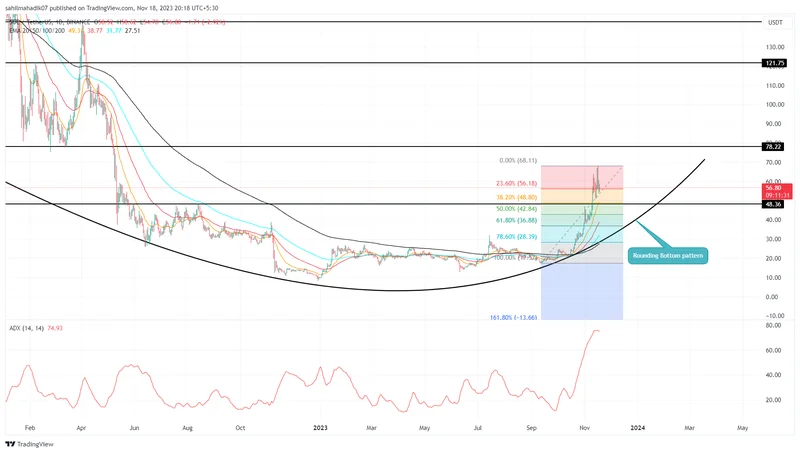The narrative around Solana (SOL) has taken a strange turn. We're seeing headlines about massive institutional inflows into new Solana exchange-traded funds (ETFs)—nearly $199 million in a week, according to some reports—while the price of SOL itself is dipping below $180. It's a discrepancy that demands a closer look.
On the surface, it seems counterintuitive. Basic economics would suggest that increased demand (as indicated by ETF inflows) should drive up the price. Yet, SOL is hovering around $175, a 6.4% daily decline and a 12% drop over the past week. The ETFs, managed by firms like Bitwise and Grayscale, hold over $500 million in assets, but that hasn't translated into upward price pressure. Why?
Analysts are pointing fingers at a broader “risk-off sentiment” in the market, driven by macroeconomic fears and uncertainty surrounding potential policy reversals. Even a lower tariff announcement from President Trump hasn't been enough to soothe investor nerves. The implication is that investors are pulling back from riskier assets across the board, and Solana is caught in the crossfire. But that explanation feels a bit too convenient.
Let's dig deeper. The article mentions Solana's strong fundamentals: annualized revenue of $2.85 billion and growth outpacing Ethereum in its early days. Western Union is even building a stablecoin on Solana. These are bullish signals, yet they're being overshadowed by short-term trading caution. Technical indicators show Solana consolidating below major moving averages, with support around $172 and resistance between $188 and $192. The RSI is nearing oversold territory, and the MACD divergence suggests weakening selling pressure.
But here's the part of the equation that I find most interesting: the ETF structure itself. Are these ETFs truly representative of new demand, or are they simply repackaging existing SOL holdings? It's possible that institutions are rotating their existing SOL into these ETFs to capture staking yields or offer a regulated investment product to their clients, without actually increasing overall demand for SOL on the open market.
This possibility raises some serious questions. How much of the $199 million inflow represents net new capital entering the Solana ecosystem versus the shuffling of existing assets? The reports don't break down the data with that level of granularity. (And that lack of transparency is exactly what makes me skeptical). Furthermore, who exactly is buying these ETFs? Are they long-term institutional investors with a deep understanding of Solana's technology, or are they retail investors chasing short-term gains based on the ETF hype?

Another headline proclaims that "Solana Price Prediction: $417M Floods Into New Bitwise ETF – Is Wall Street Quietly Going All-In on SOL?" It's a catchy narrative, but let's dissect it. Eric Balchunas, a Bloomberg ETF analyst, notes that the Bitwise SOL Staking ETF (BSOL) led inflows for the week, even outperforming Bitcoin and Ethereum ETFs. That sounds impressive, but we need to consider the context.
BSOL offers U.S. investors regulated access to SOL staking yields, a feature previously limited to on-chain participants. This is undoubtedly a positive development, but it doesn't automatically equate to a massive, sustained rally in the price of SOL. Grayscale estimates that Solana ETPs could capture 5% of all SOL tokens within two years, representing over $5 billion in value at current prices. But that's a projection, not a guarantee.
The article also points to a potential breakout from a 7-month ascending channel, with the altcoin testing a confluence of support at $175. Losing that level could trigger a 30% drop to $120, while holding it might set the stage for another breakout attempt towards $300, a potential 185% gain. The $300 level is identified as the key breakout threshold, with a successful flip of that resistance into support potentially pushing the Solana price toward $1,000.
However, the momentum indicators are mixed. The MACD histogram has crossed below the signal line, indicating a potential downtrend, while the RSI sits near a historical bottom, suggesting limited downside room. This conflicting data underscores the uncertainty surrounding Solana's near-term price action.
And here we arrive at a fundamental problem with much of the analysis surrounding crypto assets: the over-reliance on technical indicators and chart patterns without a corresponding understanding of the underlying fundamentals and market dynamics. It's like trying to predict the weather based solely on cloud formations, without considering atmospheric pressure, temperature, or wind patterns.
The influx of institutional capital into Solana ETFs is undoubtedly a positive sign for the long-term viability of the Solana ecosystem. However, it's not a magic bullet that will instantly propel the price of SOL to new heights. The short-term price action is being influenced by a complex interplay of factors, including macroeconomic sentiment, trading dynamics, and the structure of the ETFs themselves. Until we have more transparency into the composition of these ETFs and the motivations of their buyers, it's premature to declare that "Wall Street is going all-in on SOL." The data simply doesn't support that conclusion—yet.